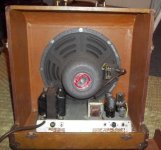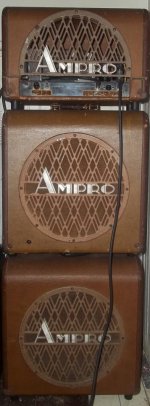This is not a concern as much as pure nuts and bolts curiosity. i have an old Ampro tube amplifier (40's? 50's?). it uses one 12ax7 and a pair of 6v6gt's, also a 5y3gt. the main question i have is twofold: although i know the 12ax7 is overdriving providing the sweetness, how much of this is also coming from the 6v6's? and secondly, is there a chance i'm risking damage from keeping the fuzzy goodness flowing at maximum at all times? i get maximum lovejuice using a pedal (simple eq) to boost the input signal, since there are no gain or level controls on the amp itself. (i use it for bass and guitar). i have read that tube amps loooove to give you great tone--right before they die. so help me a) keep it alive and b) understand what is really happening inside the magic jars. thanks.
Attachments
Last edited:
First thing as with all old amps is to replace the electrolytic capacitors, namely the power supply caps at the least. That would be the big can beside the power transformer. Second is to check that the plate voltage on the 6v6's are within tolerance since when this amp was made line voltage was ~110-112 volts instead of todays 118-122 volts. Check the cathode bias resistors to make sure they have not drifted in value.
This is probably a pretty standard circuit, 12ax7 common cathode stage into 12ax7 split load phase inverter driving the 6v6 push pull output. It was probably designed for line input/pa type use, so you probably won't get full power out of it with just the guitar plugged in without the pedal anyway.
Found a pic of the underside of this thing. Its a bit cramped so be careful with probes in there.
This is probably a pretty standard circuit, 12ax7 common cathode stage into 12ax7 split load phase inverter driving the 6v6 push pull output. It was probably designed for line input/pa type use, so you probably won't get full power out of it with just the guitar plugged in without the pedal anyway.
Found a pic of the underside of this thing. Its a bit cramped so be careful with probes in there.
Attachments
First thing as with all old amps is to replace the electrolytic capacitors, namely the power supply caps at the least. That would be the big can beside the power transformer. Second is to check that the plate voltage on the 6v6's are within tolerance since when this amp was made line voltage was ~110-112 volts instead of todays 118-122 volts. Check the cathode bias resistors to make sure they have not drifted in value.
This is probably a pretty standard circuit, 12ax7 common cathode stage into 12ax7 split load phase inverter driving the 6v6 push pull output. It was probably designed for line input/pa type use, so you probably won't get full power out of it with just the guitar plugged in without the pedal anyway.
Found a pic of the underside of this thing. Its a bit cramped so be careful with probes in there.
sooo... i guess my username should be "i-dunno-diddly-squat-bout-electronics" 😉 this mostly might as well be cuneiform, i'd understand about the same amount! i had a (knowledgeable) friend take a safety looksee and he said it's good to go. he didn't change out any components, tho, just the power cable. is this a safety issue that needs to happen no matter what? also will it change the glorious sound i get? and you are spot on about the input sensitivity. plugging straight in does yield sound (pretty good, too) but front-ending it really makes it ballsy. what i'm mostly wondering is if i'm hearing such wonderful tone due to it being near death, and if pushing it so hard all the time is putting it at risk.
as for the looks, when i got it- the pic on the left- i had two speaker boxes, all looked the same. i picked the best sounding pair of speakers, sold the driver from the third, and tore up the remaining empty box to fashion the enclosure to make the amp a head unit. everyone i've corresponded with about it says it's probably in the 15 watt range, but thru 2-12 inch speakers it's huge. i've only known solid state amps until i got this one, and i'd say it would easily keep pace with a 25 to 40 watt ss amp. the Jensen p12n's sound amazing with my Marshall head, too, so maybe it's just a perfect storm of vintage goodness. plus, after about ten minutes or so of jamming it makes the room i'm playing in smell like the inside of the boxes. maybe it's the adheasive? the vinyl? dunno, but it reminds me of my granny's house growing up🙂
anyway thanks for replies.
that is one beautiful amp. as long as it works ... don't do anything to it. if and when something stops working ask somebody with a good amount experience and patience for help. this is not a good place to start.
If your getting a "smell" then check if the big transformer is getting hot, it may be cooking the internal varnish/insulation. This is a big indication that the supply caps need changed.
oops sorry. i was talking about when i get the speakers moving it pushes out the scent. the inside of the enclosure stays nice and cool, as far as tube heads go. it's hard to see in the pic. the bottom of the orig grill is in the back of the head box, so it gets plenty of breathing room. also the box is way bigger than the chassis, and almost twice the height of the tubes and transformer. thank you for the concern, though.
as far as service or repair, being in bands for quite a while allows for a decent amount of meeting the right folks, including fellas with the proper educations and abbreviations. i wouldn't try to fix this on my own if something were to happen. waaaaay out of my league. need to wire a new speaker jack? i got it. need a probe or to troubleshoot a circuit? no way!!! oh, hey Jerluwoo i'm in Northern KY (basically Cincy) maybe you could fix it if something were to happen, huh?
i'm still curious about the power tubes-- is a significant amount of the lovely fuzz coming from them? i've noticed so many of the popular amps have multiple preamp tubes, where as this only has one, but still goes into PHAT saturation. a guy i play with says that a single 12ax7 doesn't give enough, and insists that what makes mine so sweet is the 6v6's being overdriven. i see his point, but wanted to hear from experienced tubeheads on the matter. and on a last note, is there a particular brand or alternative type of tube that i could swap out the exixting GE 12ax7 for that may give me an even fuzzier love?
as far as service or repair, being in bands for quite a while allows for a decent amount of meeting the right folks, including fellas with the proper educations and abbreviations. i wouldn't try to fix this on my own if something were to happen. waaaaay out of my league. need to wire a new speaker jack? i got it. need a probe or to troubleshoot a circuit? no way!!! oh, hey Jerluwoo i'm in Northern KY (basically Cincy) maybe you could fix it if something were to happen, huh?
i'm still curious about the power tubes-- is a significant amount of the lovely fuzz coming from them? i've noticed so many of the popular amps have multiple preamp tubes, where as this only has one, but still goes into PHAT saturation. a guy i play with says that a single 12ax7 doesn't give enough, and insists that what makes mine so sweet is the 6v6's being overdriven. i see his point, but wanted to hear from experienced tubeheads on the matter. and on a last note, is there a particular brand or alternative type of tube that i could swap out the exixting GE 12ax7 for that may give me an even fuzzier love?
 Since this is a musical instrument thread this belongs in the Instrument & Amps forum. Please read the header at the top of each forum.
Since this is a musical instrument thread this belongs in the Instrument & Amps forum. Please read the header at the top of each forum.- moderation end -
😀
Given the smell is wafting out of the driver it is possible you are frying the voice coil of that driver.
Regardless I would get all electrolytics replaced NOW with ones of equal value. Suitable caps are available from many online guitar shops, Antique Electronic Supply and Mouser or Digikey. Don't wait for a cap to short and potentially take out the power transformer and other parts.
Please replace the line cord with a three wire cord with a proper ground!!
MY BAD
duely noted. i noticed after i started this thread that i posted it in the wrong place, but figured i'd reply to later posts. the amp in question isn't actually an instrument amp, but yes i agree i should have looked for an instrument amp thread first. i have a terrible habit of seeking instant gratification and jumped on the first forum i saw related to tubes. since i'm sort of in between musical projects at the moment, i think i will take the advice here and get it in to the shop for a good, in-depth update and health checkup. i just worry about losing the vintage magic it has going on. 😱
duely noted. i noticed after i started this thread that i posted it in the wrong place, but figured i'd reply to later posts. the amp in question isn't actually an instrument amp, but yes i agree i should have looked for an instrument amp thread first. i have a terrible habit of seeking instant gratification and jumped on the first forum i saw related to tubes. since i'm sort of in between musical projects at the moment, i think i will take the advice here and get it in to the shop for a good, in-depth update and health checkup. i just worry about losing the vintage magic it has going on. 😱
Not a big deal.. 😀
Just have them do the bare minimum of a recap and check the condition of the cathode bias resistor in the output stage. Coupling caps should be replaced to the output stage grids. Other components may fail but are less likely to result in expensive damage - just a gradual degradation in performance...
Just have them do the bare minimum of a recap and check the condition of the cathode bias resistor in the output stage. Coupling caps should be replaced to the output stage grids. Other components may fail but are less likely to result in expensive damage - just a gradual degradation in performance...
- Status
- Not open for further replies.
- Home
- Live Sound
- Instruments and Amps
- What is happening to my signal?



